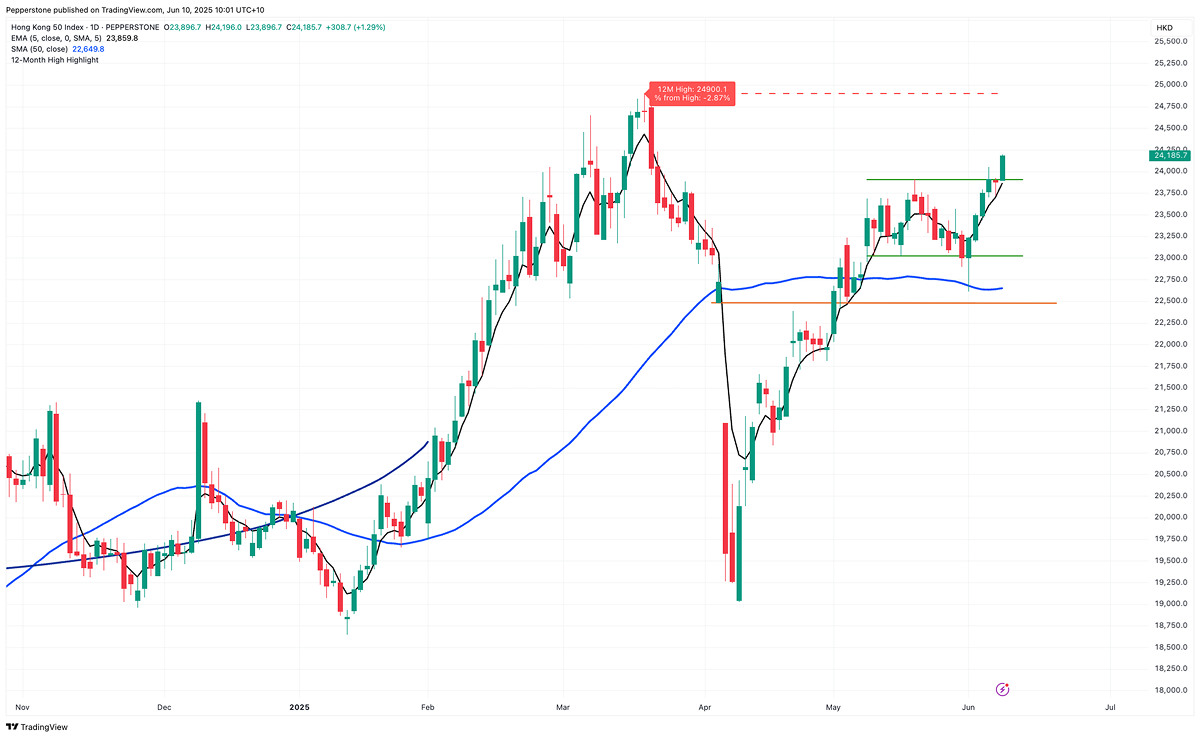- English
- 中文版
Range Breakout, Bull Market Kickoff: Can the Hang Seng Continue to Lead?
.jpg)
Since early June, the Hang Seng Index has staged a strong rebound from its 50-day moving average, breaking above the upper boundary of its May consolidation range at 23,900 on June 9. This key breakout attracted significant buying interest, propelling the index to six consecutive days of gains and firmly above the 24,000-mark - technically signaling the start of a bull market.
Amid broadly stabilized risk sentiment, this momentum has sparked market speculation about whether the Hang Seng can mount a sustained challenge to this year’s highs.

Despite the phase of trade talks easing between China and the US providing short-term support to global risk assets, China’s May activity data failed to meet expectations. This has left some traders cautious about the sustainability of the rally, which currently appears more sentiment-driven than fundamentally supported.
Trade Balance Headwinds and Ongoing Deflation Concerns
Market expectations were for a trade rebound in May following the 90-day US tariff pause. However, actual figures disappointed: exports grew just 4.8% year-on-year, well below April’s 8.1%, while imports fell 3.4%, missing forecasts overall.
Consequently, May’s trade surplus widened to $103 billion - the second highest on record - largely weighed down by a sharp drop in exports to the US, which plunged 35% year-on-year to the lowest since Q1 2020. This reflects both the deep impact of US-China trade frictions and the distortion from an export surge in April.
While China is working to diversify markets by expanding trade with Africa, ASEAN, and India, current volumes and product mixes mean these efforts cannot fully offset the US shortfall.
Meanwhile, imports from the US dropped 18%, partly dragged down by Boeing delivery suspensions. Additionally, rising penetration of domestic new energy vehicles has slashed China’s auto imports from the US by 29%, signaling some shift in reliance but not enough to counterbalance the overall trade contraction.
On the price front, despite easing energy costs, China’s CPI remained negative year-on-year in May. However, core CPI rose 0.6%, slightly beating expectations, indicating gradual domestic demand recovery and early effectiveness of consumption policies.
Overall, despite some tariff reductions, the prevailing 10% general tariffs, 20% fentanyl tariffs, and up to 50% steel and aluminum tariffs continue to pressure exports. With domestic demand still fragile, deflation risks remain a concern, and markets are keenly awaiting further progress in US-China talks to enhance China’s competitiveness globally.
Trade Tensions Easing Spurs Market Rally
Despite weak economic data, the Hang Seng’s rally reflects its high foreign investor exposure and sensitivity to policy signals.
Since the recent US-China leadership call, bilateral dialogue has warmed. The talks, initially set to end June 9, were extended, with positive feedback from the US side. This has directly buoyed market sentiment, especially after Trump’s previous accusations against China and threats to double steel and aluminum tariffs.
Further optimism stems from rumors that the US may relax export controls on certain high-tech goods like chips, potentially in exchange for China easing restrictions on rare earth exports. Notably, China has recently approved some rare earth shipments, seen as a gesture to stabilize trade relations.
However, before any concrete deal is reached, these high-level talks mainly provide short-term boosts. Structural reform concerns in China and rising US political divisions ahead of midterm elections make a comprehensive agreement challenging.
Beyond 24,000: What’s Next for the Hang Seng?
Overall, the current rebound is driven by sentiment and policy expectations rather than a fundamental turnaround. Whether the rally can continue hinges on tariff negotiation and economic recovery keeping pace with market pricing. In the near term, I believe the path of least resistance for the Hang Seng is upward.
Looking at the progress of the negotiations, if substantial breakthroughs occur before the August tariff pause expires—such as further tariff reductions or eased restrictions on high-tech imports—combined with continued domestic demand recovery and easing deflationary pressures, the Hang Seng could gain significant upward momentum.
Meanwhile, May saw a robust IPO performance with 10 new listings, including CATL and Hengrui Medicine, raising a total of HKD 55.76 billion—the highest amount since March 2021. The consumer and tech sectors now account for about half of Hong Kong’s total market capitalization, with companies like Alibaba, NetEase, BYD, and SMIC making up nearly 30% of the tech market cap.
Against a backdrop of soaring US fiscal deficits and credit rating downgrades, significant progress in China’s AI technology and sustained macro policy support could see the Hang Seng attract global capital thanks to its valuation appeal and growth prospects.
That said, with many orders absorbed early due to April’s tariff anticipations, even with room for further tariff cuts, export pressures could remain significant in H2. As a pillar of China’s “two speed” growth model, any export weakness may limit the Hang Seng’s upside potential.
The material provided here has not been prepared in accordance with legal requirements designed to promote the independence of investment research and as such is considered to be a marketing communication. Whilst it is not subject to any prohibition on dealing ahead of the dissemination of investment research we will not seek to take any advantage before providing it to our clients.
Pepperstone doesn’t represent that the material provided here is accurate, current or complete, and therefore shouldn’t be relied upon as such. The information, whether from a third party or not, isn’t to be considered as a recommendation; or an offer to buy or sell; or the solicitation of an offer to buy or sell any security, financial product or instrument; or to participate in any particular trading strategy. It does not take into account readers’ financial situation or investment objectives. We advise any readers of this content to seek their own advice. Without the approval of Pepperstone, reproduction or redistribution of this information isn’t permitted.